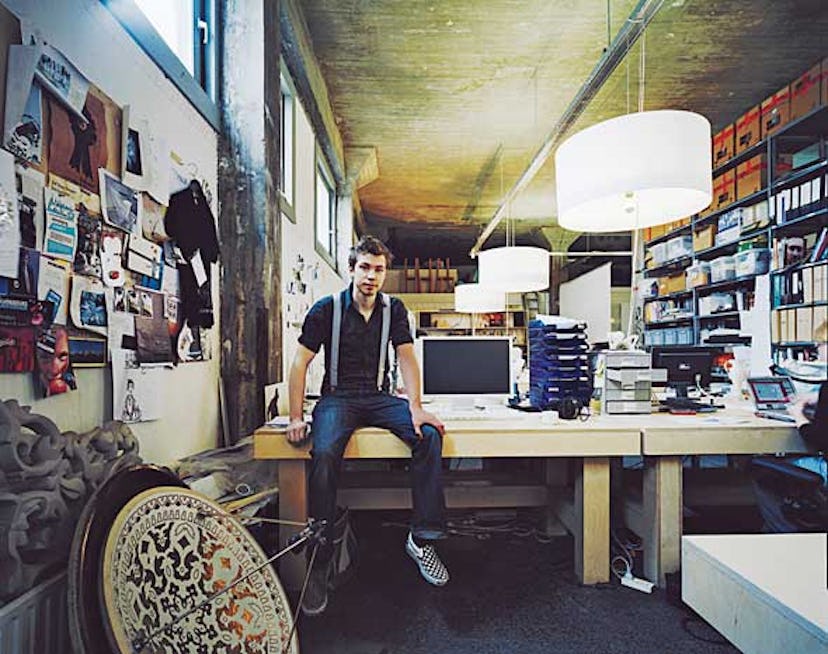Good Bones
With his Bone Chair and other creations, Dutch design hotshot Joris Laarman finds new ways to merge high tech with high style.

New faces come and go in the design world, and many of those faces, like Joris Laarman’s, are young and Dutch. Laarman made an international splash at age 23 with his senior project at design school—a modular concrete radiator whose curlicue shape he dreamed up in a half hour. But he knew better than to presume that the acclaim would last. He remembers spending one morning being interviewed about the radiator by a group of Japanese journalists before slinking off to his day job, manning the phones at an Internet customer service center.
Five years later, however, as Laarman sits in his loftlike Rotterdam studio alongside six staffers, his staying power is no longer in question. Now hailed as one of design’s most formidable talents, Laarman enjoys a particular cachet among museums and serious collectors. The Nebula chandelier he created for Flos was a favorite at last year’s Milan furniture fair (design arbiter Murray Moss later showcased the piece in his Manhattan store), and two of Laarman’s recent furniture pieces will be featured in the Museum of Modern Art’s exhibit “Design and the Elastic Mind,” opening February 24. The show’s curator, Paola Antonelli, considers Laarman a key figure in the current wave of designers exploring the soft spot where cutting-edge technology and plain old beauty converge. “Many designers are now looking at software as a way to create new forms,” she says. “Joris does it with particular elegance.”
Joris Laarman’s Bone Armchair, 2008, in porcelain, marble powder and resin
“His work is mind-blowing,” adds Li Edelkoort, chairwoman of the renowned Design Academy Eindhoven, Laarman’s alma mater, in the Netherlands. “He is changing our perspective on functionalism.”
Laarman, who dresses in a uniform of urban-surfer cool—mussed hair, suspenders, Vans sneakers—was born in the tiny Dutch village of Borculo, and spent much of his childhood building his own roller skates and parachutes. Later, after deciding that architecture school was too technical and art school too self-indulgent, he ended up at Eindhoven, where he learned that the two sides of his personality—science geek and dreamy romantic—were more compatible than he’d realized. (His radiator, with its baroque curves inspired by antique French wallpaper, happened to heat a room more efficiently than a standard metal rectangle.) “Combining reason with emotion, that’s the most difficult thing to do—in design and in everything,” Laarman says.
One extraordinary example of Laarman’s ability to merge the two is the Bone Chair, a design that he developed on a computer and then cast in aluminum. For the form, Laarman relied on software that car manufacturers use to develop the most efficient shapes for auto parts. (The software was originally inspired by the biology of human bones, whose regenerative capacity allows them to add and subtract matter as needed.) The result is a delicately sculptural object that contains no superfluous or decorative matter yet is gorgeous enough to make people marvel. “It’s as if a tree just grew out of the ground to keep you propped up,” says Antonelli, who chose the chair, along with a polyurethane chaise version of it, for the MoMA show. (A concurrent exhibit at Laarman’s New York gallery, Friedman Benda, will include the newest piece in the Bone series, an armchair in porcelain, marble powder and resin.)
The affable, low-key Laarman, who exudes the youthful confidence of a star pupil, used to moonlight as a guitarist in a rock band, though he now spends most of his time at his computer, where for inspiration he keeps hundreds of files on robots, appliances and scientific experiments. He takes a full five minutes to scroll through his photo archive of antique toasters for me, and somehow, it’s fascinating. (“Back then they used only materials that were really pure,” he says. “Every single wire was there for a reason.”) One of his current projects is a hinged desk lamp that he created by Googling images of prosthetic limbs. “They are beautiful,” Laarman says of the manmade joints. “And they use the best metals that can be found in the industry.” However whimsical his designs might seem, they’re always rooted in discipline and efficiency. The height of design absurdity, in Laarman’s opinion: the latest six-blade razor—a “stupid” example of wasteful, market-driven excess.
At heart, Laarman is a lot like an old-school inventor of the Buckminster Fuller persuasion, though his idealism is balanced by the same degree of commercial savvy that has made fellow Eindhoven alums like Maarten Baas so successful. Thanks to the high demand for Laarman’s limited-edition Bone chair and chaise (both are sold out) and his regular collaborations with design giants such as Flos and Droog, he is finding it easier to finance his own fantastical experiments. One he currently has in mind is a low-tech individual airship. “You know—a single-person chair, with balloons attached, so you can fly away,” Laarman says. “It’s really a simple thing to make, but nobody is trying it.”
bone armchair: Joris Laarman studio